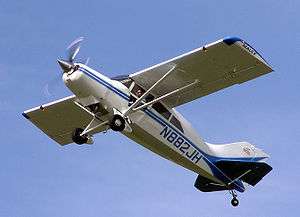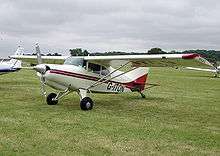Maule M-7
| M-7, MX-7, MXT-7 | |
|---|---|
 | |
| M-7-235 Super Rocket | |
| Role | Utility aircraft |
| National origin | United States |
| Manufacturer | Maule Air |
| Designer | Belford Maule |
| First flight | 1984 |
| Number built | ca. 500 by 1995 |

.jpg)
The Maule M-7 is a family of single-engine light aircraft that has been manufactured in the United States since the mid-1980s.
Design and development
Based on the Maule M-4, it is a high-wing, strut-braced monoplane of conventional configuration, available with tailwheel or optional tricycle wheeled undercarriage[1] and frequently used as a floatplane with twin floats. The basic M-7 has a longer cabin than its predecessors the M5 & M6, with two seats in front, a bench seat for up to three passengers behind them, and (like the M-6) an optional third row of "kiddie seats" at the rear.[2] Extra cabin windows can be fitted if the "kiddie seats" are to be used. The MX-7 uses the same fuselage as the M-6,which is a modified M5 fuselage but the same wing span as the M-5,[2][3] and incorporates the increased fuel tankage, hoerner style wing tip and five-position flaps designed for the M-7.[4]
The M-7 family has been produced both with piston and turboprop engines.[2][3][5]
Variants
M-7 series
- M-7-235 Super Rocket
- Similar to M-6-235 with lengthened cabin. Tailwheel undercarriage and Lycoming O-540 engine[2]
- M-7-235B Super Rocket[6]
- Same as M7-235 including Oleo-Strut main landing gear.
- M-7-235C Orion[6]
- Same as M7-235B but with sprung aluminum main landing gear and Lycoming IO-540 engine.
- M-7-260[6]
- M-7-260C[6]
- M-7-420 Starcraft Turboprop
- M-7-235 with Allison 250 turboprop engine[2]
- MT-7-235 Tri-Gear
- Super Rocket with tricycle undercarriage[2]
- MT-7-260[6]
MX-7 series
- MX-7 Rocket[6]
- MX-7-160 Sportplane
- M-6 fuselage with M-5 wings. Lycoming O-320 engine[2][6]
- MX-7-180 Star Rocket
- MX-7 with lengthened cabin. Optional third row of seats with windows. Lycoming O-360 engine[2]
- MX-7-180A Sportplane and Comet
- MX-7-180B Star Rocket[6]
- MX-7-180C Millennium[6]
- MX-7-250 Starcraft
- MX-7 with Allison 250 turboprop engine[2]
- MX-7-420 Starcraft Turboprop
- MX-7-235 with Allison 250 turboprop engine[2]
- MXT-7-160 Comet
- MX-7-160 with tricycle undercarriage
- MXT-7-180 Star Rocket
- MX-7-180 with tricycle undercarriage[2]
Specifications (M-7-235)
Data from Jane's All the World's Aircraft 1985–86, p. 449
General characteristics
- Crew: One pilot
- Capacity: 4 passengers
- Length: 23 ft 6 in (7.16 m)
- Wingspan: 33 ft 6 in (10.21 m)
- Height: 6 ft 3 in (1.89 m)
- Wing area: 168 ft2 (15.6 m2)
- Empty weight: 1,500 lb (681 kg)
- Gross weight: 2,500 lb (1,134 kg)
- Powerplant: 1 × Lycoming IO-540-W, 235 hp (175 kW)
Performance
- Cruise speed: 164 mph (265 km/h)
- Range: 1,001 miles (1,610 km)
Notes
- ↑ Maule Air (1 January 2012). "Standard Equipment - MX(T)-7 Series and M(T)-7 Series Maule Aircraft" (PDF). Retrieved 17 June 2012.
- 1 2 3 4 5 6 7 8 9 10 11 Simpson 1995, 242
- 1 2 Jane's All the World's Aircraft 1985–86, 448
- ↑ "Private Aircraft Buyers' Guide" 1986, 39.
- ↑ "Maule develops turboprops" 1987, 16
- 1 2 3 4 5 6 7 8 9 World Aircraft Information Files, File 901 Sheet 08
References
| Wikimedia Commons has media related to Maule M-7. |
- Jane's All the World's Aircraft 1985–86. London: Jane's Publishing.
- "Maule develops turboprops". Flight International. 2 May 1987. Retrieved 2008-12-27.
- "Private Aircraft Buyers' Guide". Flight International: 37–48. 15 March 1986. Retrieved 2008-12-27.
- Simpson, R. W. (1995). Airlife's General Aviation. Shrewsbury: Airlife Publishing. ISBN 1-85310-577-5.
- Taylor, Michael J. H. (1989). Jane's Encyclopedia of Aviation. London: Studio Editions. ISBN 0-7106-0710-5.
- World Aircraft Information Files. London: Bright Star Publishing. ISBN 1-156-94382-5.